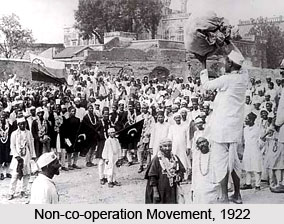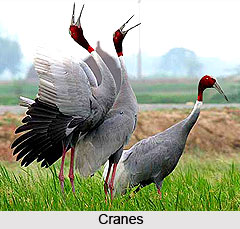 Etawah is located in Uttar Pradesh and forms a part of the Kanpur Division. In its shape it looks like a parallelogram. Etwah is bounded on the north by the districts of Farrukhabad and Mainpuri, while the small extent of western border adjoins tahsil Bah of the Agra district. The major rivers that flow through Etwah are Chambal and Yamuna. The average annual rainfall in the district is 792 mm. During the rainy season the relative humidity is generally high being over 70%. There is a steady increase in temperature after February. May is the hottest month. The nights are warmer in June than in May. The heat in the summer is intense and the hot, dry and dust-laden westerly winds, which are common in the hot season, make the weather severely trying. During the cold season the district as affected by cold waves and fog and the minimum temperature occasionally goes down to 3 °C.
Etawah is located in Uttar Pradesh and forms a part of the Kanpur Division. In its shape it looks like a parallelogram. Etwah is bounded on the north by the districts of Farrukhabad and Mainpuri, while the small extent of western border adjoins tahsil Bah of the Agra district. The major rivers that flow through Etwah are Chambal and Yamuna. The average annual rainfall in the district is 792 mm. During the rainy season the relative humidity is generally high being over 70%. There is a steady increase in temperature after February. May is the hottest month. The nights are warmer in June than in May. The heat in the summer is intense and the hot, dry and dust-laden westerly winds, which are common in the hot season, make the weather severely trying. During the cold season the district as affected by cold waves and fog and the minimum temperature occasionally goes down to 3 °C.
History of Etwah
In 1914-15 Etwah became the center of revolutionary activity when Gendalal Dixit organized the Shivaji Samiti with the object of liberating the country. Gendalal Dixit had also organized a group of young men called "Matri-Vedi".
When Gandhiji emerged to the forefront after returning from the first session of the Congress that was held at Lucknow, a large number of people came to the forefront to take part in the freedom struggle. The national movement had so far been confined to the urban intelligentsia but his appearance on the Indian political scene gave a new direction and meaning to the freedom struggle, which was now carried to the masses. In Etawah a large number of persons enrolled themselves as volunteers.
In 1920, the Congress declared "the attainment of Swarajya by the people of India by all legitimate and peaceful means." Mahatma Gandhi launched his famous Non-co-operation Movement all over the country in August of that year. In Etawah the response of the people to this movement was enthusiastic and widespread. In 1920-21 the district Congress Committee was formed with Maulana Rahmat Ullah as its president. He was soon arrested by the authorities.
In 1922, Mahatma Gandhi suspended the Non-co-operation Movement. The movement roused the consciousness of the people against alien rule and gave them a new confidence and courage to fight it. In the council election, the Congress won a seat in the council election.
In 1925, Jyoti Shankar Dixit of Lalpura village and Mukandi Lal of Etawah city were arrested in connection with the Kakori Conspiracy case but were later released. In 1928, when the Simon Commission visited India it was subjected to boycott all over the country and Jawaharlal Nehru visited Etawah in this connection.
On November 23, 1929 Gandhiji visited the district and addressed a large public meeting at Auraiya. In 1930, the Civil Disobedience movement was started in Etawah. The first stage was violation of the Salt Act. Many people were arrested and lathi charged.
The students of the Government Intermediate College, Etawah, were lathi charged for hoisting the Congress flag on the college building. Thousands assembled to protest against this act of oppression.
The people of the district kept up their non-violent struggle as per the instructions of Gandhiji. British goods were boycotted and foreign clothes were burnt publicly.
A large number of peasants also joined the Congress. All the political prisoners were released as a result of the Gandhi-Irwin Pact in 1931.
The Quit India Movement of 1942 received wide support from people in the district.
Congress flag was hoisted on all Congress offices and on numerous private buildings. There were mass arrests, imposition of collective fines, and lathi charges.
There was universal discontent against British rule and was the indication that British could no longer rule India. In 1947, by passing the Indian Independence Act, the British decided to quit India.
On August 15, 1947, the country was liberated from the British rule. The district of Etwah enjoyed the freedom movement along with India. The private and government buildings of Etwah were hoisted with flags.
The Government honored 548 freedom fighters of Etwah with Tamra Patras.
This is a number, which any district can boast of without exaggerating its role. This indicates that the people of Etwah are inborn patriots.
Flora and Fauna of Etwah
The district of Etwah was earlier filled with wastelands. In 1888, it was Mr. Fisher, the then collector of Etawah pioneered the protection of land from erosion by planting forests. This forest is said to be largely responsible for saving Etawah city from the erosive action of the Yamuna. The Total forest area of Etwah is 301.04 sq. km, which constitutes 12.52% of the total geographical area. The flora of Etawah district comprise 560 species out of it 123 species are medicinal plants like Arjun, Neem, Bel, Indra Jav, Babool and Arvsa.
The trees found in the district are Dhak, Aonla, Arjun , Ashok, Asna, Bahera, Bargad, Barhal, Bel, Eucalyptus, Gular, Gul Mohar, Jamun, Kaitha, Kathal , Khair, Mahua, Litchi, Neem, Pipal, Sagon, Silver Oak, Kala siris, Safed Siris and Shisham. Grasses like Dub, Baib, Kans and spear grass are also found in abundance.
The fauna of the district are hyenas, wolves, Indian foxes, jackals, porcupines, monkeys, wild cats, hares and otters. The reptiles found here are crocodiles, turtles, tortoises, and lizards of all kinds ranging from the large tree-climbing animals called gosamp to the harmless house lizard. Snakes are not so abundant as in other districts except cobra and the krait.
There are a variety of birds in the district as kala titar or black partridge, gray parridge, quails, bater, lava , blue-rock pigeons, green pigeons ,ducks, pochards, sheldrakes and goose, peacocks, cranes, herons, waders, doves, parakeet, sparrows, shrikes, crows, rollers and other passerine birds.
 The fishes found here are rohu, mullet, mugri, dingar, haren, bas, kalwas, chal, katiya, ghegra, bighun, jhingra, grach, bam, papta, pariyasi, gudheya, tengan, siland, and jhinga are found.
The fishes found here are rohu, mullet, mugri, dingar, haren, bas, kalwas, chal, katiya, ghegra, bighun, jhingra, grach, bam, papta, pariyasi, gudheya, tengan, siland, and jhinga are found.
Economy of Etwah
Etwah has a good agricultural base. The chief Kharif crops cultivated here are bajra, jowar, paddy and maize. Another important Kharif crop is rice. Among the Kharif cereals small pulses known as Moth, Urd and Moong, the small millet Mandua, and Hemp or Sanai are grown in the district. The Rabi crops cultivated here are wheat, barley and gram. The only other Rabi staple which needs mention is peas. Cash crops like sugar-cane, ground-nut, linseed and rape-seed, vegetables and fruits, hemps, tobacco, sweet potato, condiments and spices are the main non-food crops of the district. The kharif vegetables comprise Lady-fingers, Gourds, Spinach, Brinjal etc., and those of Rabi comprise Cauliflowers, Cabbage, Tomatoes, Potatoes, Rradishes, Brinjal and turnip
There are 27809 industries here. There is only one large-scale unit that produces cotton yarn. There are small scale industries where oil, wheat flour, dal, rice, chemicals, engineering goods, plastic goods, grass ware, electricals, leather goods, and textile and allied products are produced in a large number. There are 53 agro-based Industries located at Etwah. Agricultural implements, ploughs, crushers, buckets and pans are produced in 46 units.
Candles, chalks, boot polish washing soap, ink, tooth powder and Ayurvedic medicines are manufactured in 49 units in the district. Plastic badges, containers, ornament cases, droppers, spectacles, frames, photo frames and other goods are manufactured in 3 units. Optical lenses, and other crude glass articles, cement jalies, pipes, etc. are manufactured in 14 units in the district. The manufacture of miniature bulbs and battery charging is done by 2 units. Shoes, chappals, suitcases etc. are manufactured in 15 units, in the district. Bed-sheets, lungees, curtains and dhotis are manufactured in 20 units, scattered throughout the district. Building material, printing card board boxes, ready made garments, ice candy and bricks are produced in 54 units in the district. Biscuits and other confectionary articles are produced in two units, located at Etawah.
Demography of Etwah
As per the 1991census, the population of the district was 4242310. The density of the population was 946 persons per sq. km. The sex ratio is 816 females per 1000 males in rural area and 870 females per 1000 males in urban area.
Culture of Etwah
The people of Etwah constitutes of Hindus, Muslims, Sikhs, Christians, Jains and Buddhists. Hindus constituted majority of the population. The major community of Hindus were originally divided into four branches as Brahmana, Kshatriya, Vaishya and Sudra. There are several social groups like Kayasths, Gujars etc. The hierarchical order of the Hindu castes is Chamar, Ahirs, Brahmans, Rajputs, Chauha and Sengars.
The majority of the Muslims in the district belong to the Sunni sect. Among them the most numerous are the Sheiks. Pathans are more evenly distributed than Sheiks. The remaining Muslim subdivisions, mostly occupational are the Darzi, Hajjam, Dhobi, Qassab, Faqir, Lohar and Bhisti etc.
The Sikhs constitutes 0.12% of the district population. The Christians constitute only 0.01 per cent of the district population. 0.17% of the total population are Jains. They are usually called Saraogis. Buddhists constitutes 0.27 percent of the district population.
Transportation in Etwah
Etwah is well connected by road as well as by rail. Planned development of means of transportation and the construction of new roads are undertaken by the public works department. Roads are also constructed by the forest department to facilitate the export of forest produce in the area under its jurisdiction.
The mode of conveyance till the coming of railways were palanquins, horses, camels, and vehicles drawn by bullocks, buffaloes, horses and camels. With the construction of metalled roads speedy mechanized transport made its appearance. The bicycle is popular both in rural and urban areas. In urban areas the cycle-rickshaw is popular means of conveyance and has replaced ekkas and tongas.
There are also motor trucks and buses that serves as a mode of transport. The district is linked with all the adjoining districts of Kanpur, Jalaun, Farrukhabad, Mainpuri and Agra through these buses. Etawah now lies on the northern railways with head quarters at New Delhi. There are 6 railway stations in the district, Sarai Bhupat, Jaswantnagar, Balrai, Ekdil , Bharthana and Samho.



















